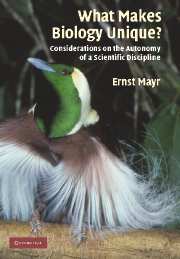Book contents
- Frontmatter
- Contents
- Preface
- Acknowledgments
- Introduction
- 1 Science and sciences
- 2 The autonomy of biology
- 3 Teleology
- 4 Analysis or reductionism?
- 5 Darwin's influence on modern thought
- 6 Darwin's five theories of evolution
- 7 Maturation of Darwinism
- 8 Selection
- 9 Do Thomas Kuhn's scientific revolutions take place?
- 10 Another look at the species problem
- 11 The origin of humans
- 12 Are we alone in this vast universe?
- Glossary
- Index
- References
4 - Analysis or reductionism?
Published online by Cambridge University Press: 10 December 2009
- Frontmatter
- Contents
- Preface
- Acknowledgments
- Introduction
- 1 Science and sciences
- 2 The autonomy of biology
- 3 Teleology
- 4 Analysis or reductionism?
- 5 Darwin's influence on modern thought
- 6 Darwin's five theories of evolution
- 7 Maturation of Darwinism
- 8 Selection
- 9 Do Thomas Kuhn's scientific revolutions take place?
- 10 Another look at the species problem
- 11 The origin of humans
- 12 Are we alone in this vast universe?
- Glossary
- Index
- References
Summary
It is only common sense to believe that a complex phenomenon cannot be fully understood unless it is dissected into smaller components, each of which must be studied separately. This approach was already adopted in principle by the Ionian philosophers when they reduced natural phenomena to four basic elements – earth, water, air, and fire – and analysis has been a tradition in philosophy and science ever since. The anatomist did not study the body as a whole but attempted to understand its workings by dissecting it into the component organs, nerves, muscles, and bones. The objective of microscopy was the study of smaller and smaller components of tissues and cells. The endeavor to carry the analysis to ever-lower levels, to ever-smaller components, was at first motivated primarily because it is such a heuristic methodology.
Much of the history of biology is a tale of the triumphs of this analytical approach. Organic diversity as a whole was unmanageable until organisms were segregated into species. The cell theory of Schwann and Schleiden was such a success because it showed that both plants and animals consisted of the same basic structural elements: cells. Physiology made its most important findings through the most careful analysis of the major organs down to cells and macromolecules. And a similar success of analysis can be shown for any biological discipline. Owing to this unbroken history of successes, no one would question the heuristic importance of analysis.
- Type
- Chapter
- Information
- What Makes Biology Unique?Considerations on the Autonomy of a Scientific Discipline, pp. 67 - 82Publisher: Cambridge University PressPrint publication year: 2004



